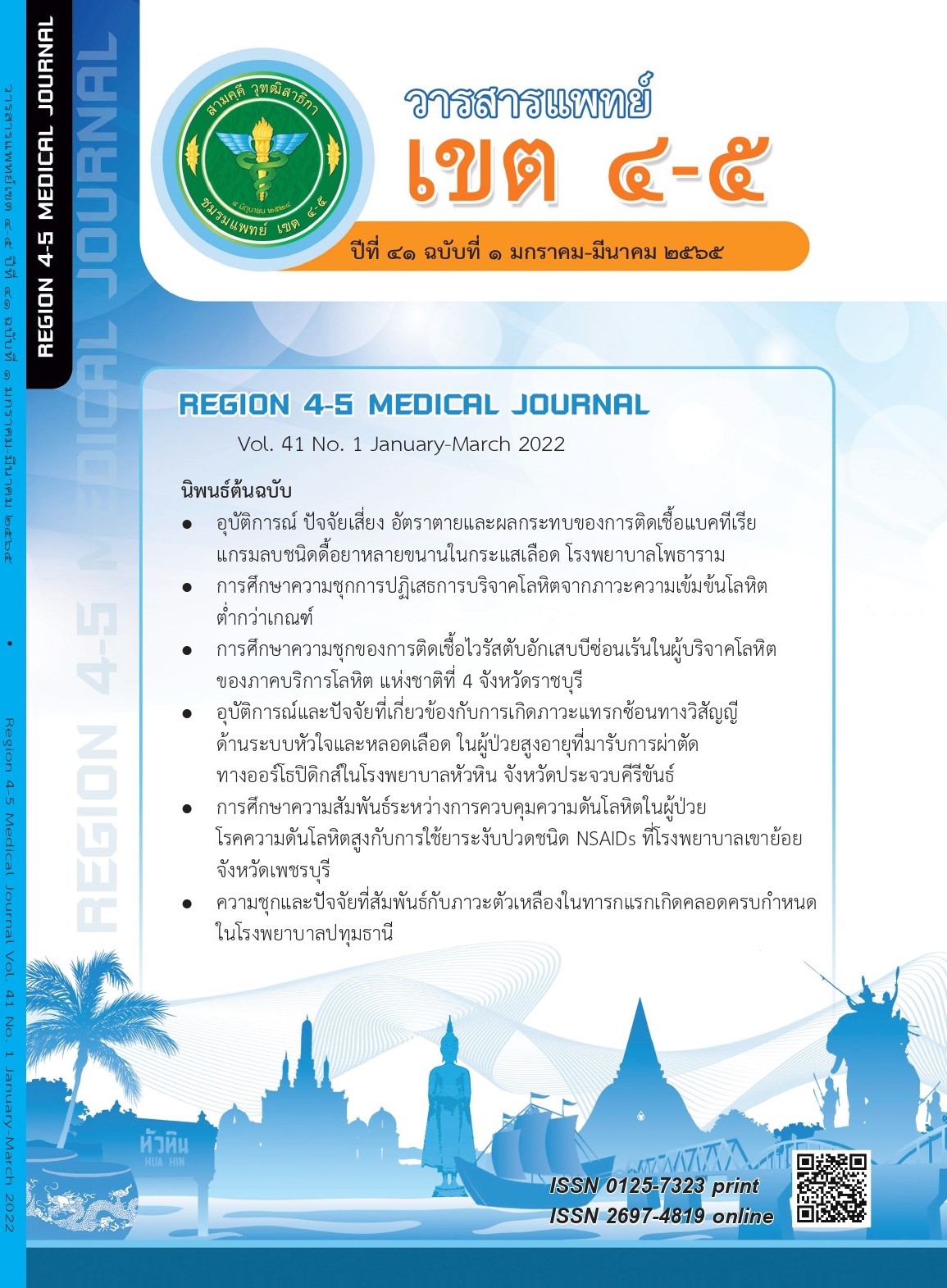อุบัติการณ์และปัจจัยที่เกี่ยวข้องกับการเกิดภาวะแทรกซ้อนทางวิสัญญีด้านระบบหัวใจและหลอดเลือด ในผู้ป่วยสูงอายุที่มารับการผ่าตัดทางออร์โธปิดิกส์ในโรงพยาบาลหัวหิน จังหวัดประจวบคีรีขันธ์
คำสำคัญ:
ภาวะแทรกซ้อนทางระบบหัวใจและหลอดเลือด, การระงับความรู้สึก, ออร์โธปิดิกส์, ผู้สูงอายุบทคัดย่อ
วัตถุประสงค์: ผู้สูงอายุมีโอกาสเข้ารับการผ่าตัดทางออร์โธปิดิกส์มากกว่าประชากรช่วงอายุอื่น รวมถึงมีแนวโน้มที่จะเกิดภาวะแทรกซ้อนหลังให้ยาระงับความรู้สึกมากขึ้น โดยเฉพาะอย่างยิ่งระบบหัวใจและหลอดเลือด เนื่องมาจากการเสื่อมถอยของอวัยวะต่างๆ และการเปลี่ยนแปลงทางสรีระวิทยาของร่างกาย การศึกษานี้จึงมีวัตถุประสงค์เพื่อหาอุบัติการณ์การเกิดภาวะแทรกซ้อนทางวิสัญญีด้านระบบหัวใจและหลอดเลือดและปัจจัยที่เกี่ยวข้อง
วิธีการศึกษา: การศึกษานี้เป็นการศึกษาเชิงวิเคราะห์แบบย้อนหลัง ประชากรที่ศึกษา คือ ผู้ป่วยอายุมากกว่า 60 ปี ที่เข้ารับการผ่าตัดทางออร์โธปิดิกส์ ตั้งแต่วันที่ 1 เดือนตุลาคม พ.ศ. 2558 ถึงวันที่ 30 เดือนกันยายน พ.ศ. 2563 โดยเก็บข้อมูลจากเวชระเบียนและใบบันทึกการให้การระงับความรู้สึก ผู้วิจัยใช้การวิเคราะห์ทางสถิติด้วย multivariate logistic regression เพื่อหาปัจจัยเสี่ยงของการเกิดภาวะแทรกซ้อนดังกล่าว และกำหนดค่านัยสำคัญทางสถิติที่ p-value < .05
ผลการศึกษา: ผู้ป่วยสูงอายุมารับการผ่าตัดทั้งหมด 1,734 ราย ค่าเฉลี่ยของอายุเท่ากับ 70.27 ± 7.91 ปี เป็นเพศหญิงร้อยละ 66.2 และ ASA physical status II ร้อยละ 63.5 โดยร้อยละ 50 ของผู้ป่วยได้รับการระงับความรู้สึกเฉพาะส่วน มีผู้ที่เกิดภาวะแทรกซ้อนด้านระบบหัวใจและหลอดเลือดร้อยละ 58.2 โดยภาวะแทรกซ้อนที่พบบ่อยมากที่สุดคือ ภาวะความดันโลหิตต่ำ คิดเป็นร้อยละ 46.5 การวิเคราะห์ตัวแปรแบบพหุปัจจัยพบว่า อายุ 70 ปี ขึ้นไป (OR 1.32, 95% CI 1.06–1.63) ระยะเวลาการระงับความรู้สึก (OR 1.36, 95% CI 1.23–1.51) และเทคนิคการให้ยาระงับความรู้สึกแบบเฉพาะส่วน (OR 1.4, 95% CI 1.14–1.72) สัมพันธ์กับการเกิดภาวะแทรกซ้อนดังกล่าวอย่างมีนัยสำคัญทางสถิติ (p-value < .05)
สรุป: ผู้ป่วยสูงอายุที่มารับการผ่าตัดออร์โธปิดิกส์ พบอุบัติการณ์การเกิดภาวะแทรกซ้อนทางระบบหัวใจและหลอดเลือดได้ค่อนข้างสูง โดยเฉพาะภาวะความดันโลหิตต่ำ การประเมินและเตรียมความพร้อมผู้ป่วยสูงอายุจึงเป็นสิ่งสำคัญ รวมถึงการเลือกวิธีระงับความรู้สึกให้เหมาะสมกับผู้ป่วย มีการเฝ้าระวังอย่างใกล้ชิดระหว่างผ่าตัด และการเลือกใช้ยาที่มีผลต่อระบบหัวใจและหลอดเลือดน้อยที่สุด
เอกสารอ้างอิง
กรมกิจการผู้สูงอายุ กระทรวงมหาดไทย. สถิติผู้สูงอายุของประเทศไทย 77 [อินเทอร์เน็ต]. 2562 [เข้าถึงเมื่อ 1 กรกฎาคม 2564]; เข้าถึงได้จาก: https://www.dop.go.th/download/knowledge/th1580099938-275_1.pdf
สำนักงานสถิติแห่งชาติ. รายงานการสำรวจประชากรสูงอายุในประเทศไทย พ.ศ. 2560. 2018 [อินเทอร์เน็ต]. 2561 [เข้าถึงเมื่อ 5 กรกฎาคม 2564]; เข้าถึงได้จาก: https://1th.co/go5vs5vs5vs
สำนักงานสภาพัฒนาการเศรษฐกิจและสังคมแห่งชาติ. สถิติด้านประชากร. 2019. 2562 [อินเทอร์เน็ต]. 2561 [เข้าถึงเมื่อ 5 กรกฎาคม 2564]; เข้าถึงได้จาก: https://www.nesdc.go.th/main.php?filename=social
Tuchinda L, Sukchareon I, Kusumaphanyo C, et al. The Thai Anesthesia Incident Monitoring Study (Thai AIMS): an analysis of perioperative complication in geriatric patients. J Med Assoc Thai 2010;93(6):698-707.
Chalacheewa T. SC, Apinyachon W, Sangasilp I. The Incidence and Risk Factors of Major Cardiovascular Complications. Thai J Anesthesiology 2011;37(1):34–46.
Pumsaimoon N. Risk Factors of Major Cardiovascular Complications during Surgery among Elderly Patients in Vachira Phuket Hospital. Region 11 Medicine Journal 2017;31(4):675–84.
Raddaoui K, Khedhri W, Zoghlami K, et al. Perioperative morbidity in total knee arthroplasty. Pan Afr Med J 2019;33:233.
Urban MK, Wolfe SW, Sanghavi NM, et al. The Incidence of Perioperative Cardiac Events after Orthopedic Surgery: A Single Institutional Experience of Cases Performed over One Year. HSS J 2017;13(3):248–54.
Charuluxananan S, Sriraj W, Punjasawadwong Y, et al. Perioperative and Anesthetic Adverse events in Thailand (PAAd Thai) incident reporting study: Anesthetic profiles and outcomes. Asian Biomedicine 2017;11(1):21–32.
Acheampong D, Guerrier S, Lavarias V, et al. Risk factors contributing to cardiac events following general and vascular surgery. Ann Med Surg (Lond) 2018;33:16–23.
Hofhuizen C, Lemson J, Snoeck M, et al. Spinal anesthesia-induced hypotension is caused by a decrease in stroke volume in elderly patients. Local Reg Anesth 2019;12:19–26.
Ferré F, Martin C, Bosch L, et al. Control of Spinal Anesthesia-Induced Hypotension in Adults. Local Reg Anesth 2020;13:39–46.
Mala M. Factors Related to the Occurrence of Cardiovascular Complications during Surgery among Older Adults. Southern College Network Journal of Nursing and Public Health 2015;3(2):92–101.
Zheng X, Tan Y, Gao Y, et al. Comparative efficacy of Neuraxial and general anesthesia for hip fracture surgery: a meta-analysis of randomized clinical trials. BMC anesthesiol 2020;20(1):162.
Chu C-C, Weng S-F, Chen K-T, et al. Propensity Score–matched Comparison of Postoperative Adverse Outcomes between Geriatric Patients Given a General or a Neuraxial Anesthetic for Hip Surgery: A Population-based Study. Anesthesiology 2015;123(1):136–47.
Perlas A, Chan VWS, Beattie S. Anesthesia Technique and Mortality after Total Hip or Knee Arthroplasty: A Retrospective, Propensity Score–matched Cohort Study. Anesthesiology 2016;125(4):724–31.
Kessler J, Marhofer P, Hopkins PM, et al. Peripheral regional anaesthesia and outcome: lessons learned from the last 10 years. British Journal of Anaesthesia 2015;114(5):728–45.
Memtsoudis SG, Poeran J, Cozowicz C, et al. The impact of peripheral nerve blocks on perioperative outcome in hip and knee arthroplasty-a population-based study. PAIN 2016;157(10).
Katz RI, Cimino L, Vitkun SA. Preoperative medical consultations: impact on perioperative management and surgical outcome. Can J Anaesth 2005;52(7):697–702.
Wijeysundera DN, Austin PC, Beattie WS, et al. Outcomes and Processes of Care Related to Preoperative Medical Consultation. Arch Intern Med 2010;170(15):1365–74.
George TJ, Arnaoutakis GJ, Merlo CA, et al. Association of Operative Time of Day With Outcomes After Thoracic Organ Transplant. JAMA 2011;305(21):2193–9.
Borges FK, Bhandari M, Guerra-Farfan E, et al. Accelerated surgery versus standard care in hip fracture (HIP ATTACK): an international, randomised, controlled trial. The Lancet 2020;395(10225):698–708.
ดาวน์โหลด
เผยแพร่แล้ว
รูปแบบการอ้างอิง
ฉบับ
ประเภทบทความ
สัญญาอนุญาต

อนุญาตภายใต้เงื่อนไข Creative Commons Attribution-NonCommercial-NoDerivatives 4.0 International License.
ลิขสิทธิ์บทความเป็นของผู้เขียนบทความ แต่หากผลงานของท่านได้รับการพิจารณาตีพิมพ์ลงวารสารแพทย์เขต 4-5 จะคงไว้ซึ่งสิทธิ์ในการตีพิมพ์ครั้งแรกด้วยเหตุที่บทความจะปรากฎในวารสารที่เข้าถึงได้ จึงอนุญาตให้นำบทความในวารสารไปใช้ประโยชน์ได้ในเชิงวิชาการโดยจำเป็นต้องมีการอ้างอิงถึงชื่อวารสารอย่างถูกต้อง แต่ไม่อนุญาตให้นำไปใช้ในเชิงพาณิชย์




